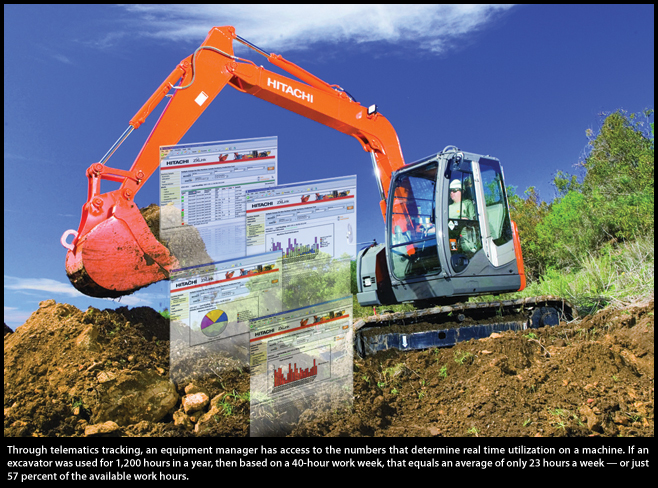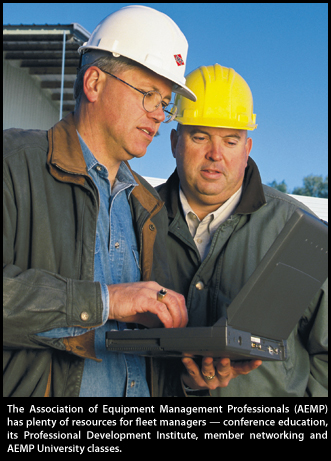Fundamentals of Fleet Finance
An equipment manager wears a lot of hats. From monitoring multiple staff members and tracking telematics data to preventative maintenance and budget planning, day-to-day responsibilities are countless. One of the most important hats an equipment manager wears has to be financial analyst. Every decision a fleet manager makes affects the company’s bottom line in one way or another, making financial knowledge and decision-making crucial. This high level of fiscal responsibility can seem overwhelming, as there is a lot to know, but there are resources out there to help guide fleet managers in making sound decisions.

The Association of Equipment Management Professionals (AEMP) has resources such as conference education, its Professional Development Institute, member networking and AEMP University classes that can assist. AEMP’s approach to fleet management education is based on 17 core competencies it has identified as necessary to be an effective equipment professional — and it’s no coincidence all of them touch on financial issues.
Simply attaining this knowledge isn’t enough. Equipment managers must be able to apply it to their day-to-day work environments, and just starting with the basics will provide a solid foundation for building a healthy financial plan. Here are the key components of three major areas every equipment manager must know.
Costs
The “s” at the end of this key word is an important designation. Cost effectiveness is more than just analyzing the lump sum of a fleet’s operating costs. It’s about knowing all of the individual numbers that go into that grand total. One of the most basic and standard ways to review and analyze costs is the company’s income statement. This document is one of the most widely used in business, and summarizes revenue and expenses over a period of time.
The major area for analysis on an income statement is the Cost of Goods Sold. This figure shows what it cost the company to generate the income statement’s reported revenue. Everything from fuel to replacement parts falls here. Proper analysis of the Costs of Goods Sold can shed light on strategies or adjustments that can be implemented to improve efficiency in small but significant areas. For example, a fleet manager may identify fuel costs as an area that could and should be reduced, and implementing a written idle policy might emerge as the best practice to reduce total usage.
PMI (Preventative Maintenance)
In addition to a firm grasp on costs, financially-healthy fleets typically have this in common: A world-class preventative maintenance (PM) program. The purpose of a PM program is to ensure routine maintenance and replacements are done at the appropriate time to prevent bigger problems — and additional, unexpected costs — from cropping up later.
The most successful PM programs are built on a proactive approach, identifying areas to address before they become a major problem. A proactive approach means setting planned inspection intervals, based on a combination of manufacturer’s recommendations and the fleet manager’s intuition and experience, following through in a timely, efficient manner. These intervals are often identified in terms of fuel consumption, hours of operation or mileage — or a combination of factors — and include every task from changing engine oil to scheduling major replacements. A proactive PM program does require a significant time and effort investment on the part of the equipment manager and the team of technicians. But it ends up costing far more to not have a proactive PM program.

Consider a general example: Based on average wear characteristics, let’s say a haul truck’s brake pads have 1,000 miles of expected use. Through standard telematics tracking methods as part of the proactive PM program, the equipment manager will know when a vehicle hits the 1,000-mile mark and the brake pads should be replaced. To replace at this time can be done for a cost of $155. If the brake pads are not replaced at this time, the rotor will likely be damaged, and cost skyrockets to $230 — that’s in addition to the original cost to simply replace the worn pads. This is a 48 percent increase in the cost of maintenance that could have been avoided with simple attention to detail and a proactive program. Added to that is perhaps the greatest cost of all — downtime. Significant repairs result in significantly increased downtime. Over time, multiple instances, such as this, increase operating costs.
Utilization
The final, major financial element to consider is utilization. What makes this concept so crucial for a fleet manager to understand is that he or she is often the only person at an organization who can provide this valuable analysis. It comes into play during a company’s annual budgeting phase — a major component of every organization’s overall financial plan.
Equipment is only bringing revenue and value when it’s working at full potential. An under utilized vehicle is more of a drain than simply leaving missed revenue on the table. Every piece of equipment costs money just to own; every one is budgeted into the PM plan, and requires costs that show up on the income statement like routine maintenance, fuel, cleaning and various other items.
Through his or her chosen strategy of telematics tracking, the equipment manager has access to the numbers that determine real time utilization on a machine. For example, if an excavator was used for 1,200 hours in a year, then based on a 40-hour work week, that equals an average of only 23 hours a week — or just 57 percent of the available work hours. Not only is that wasteful, it raises the question: Is this machine bringing enough value to justify the cost of ownership? In the estimating process of budgeting, an equipment manager can offer suggestions that can increase time utilization for the upcoming year; in this case, reducing the number of total excavators to allow for maximized utilization of the remaining fleet.
On the other hand is the concept of over utilization, which can also result in missed revenue opportunity. Imagine a small contractor with a fleet only consisting of two excavators. Those two excavators could be constantly busy on various jobsites, going from one to the next, and achieving 100 percent utilization — but this might be telling the fleet manager there’s a big problem and the company needs additional equipment. What if the owner has to turn down a job because those two excavators are already committed to projects? That’s a major missed opportunity. A balance must be struck to achieve maximum utilization.
To sum up, costs, PM and utilization are three of the major and most impactful areas to financial health. Though the tips given here are just scratching the surface, these three areas will give equipment managers solid building blocks to begin improving their fleet’s and company’s financial bottom line.
Stan Orr is president and chief security officer of AEMP, based in Glenwood Springs, Colo. Additional contribution to this article was provided by Bill Vanden Brook, the fleet service superintendent for the City of Madison, Wis.
